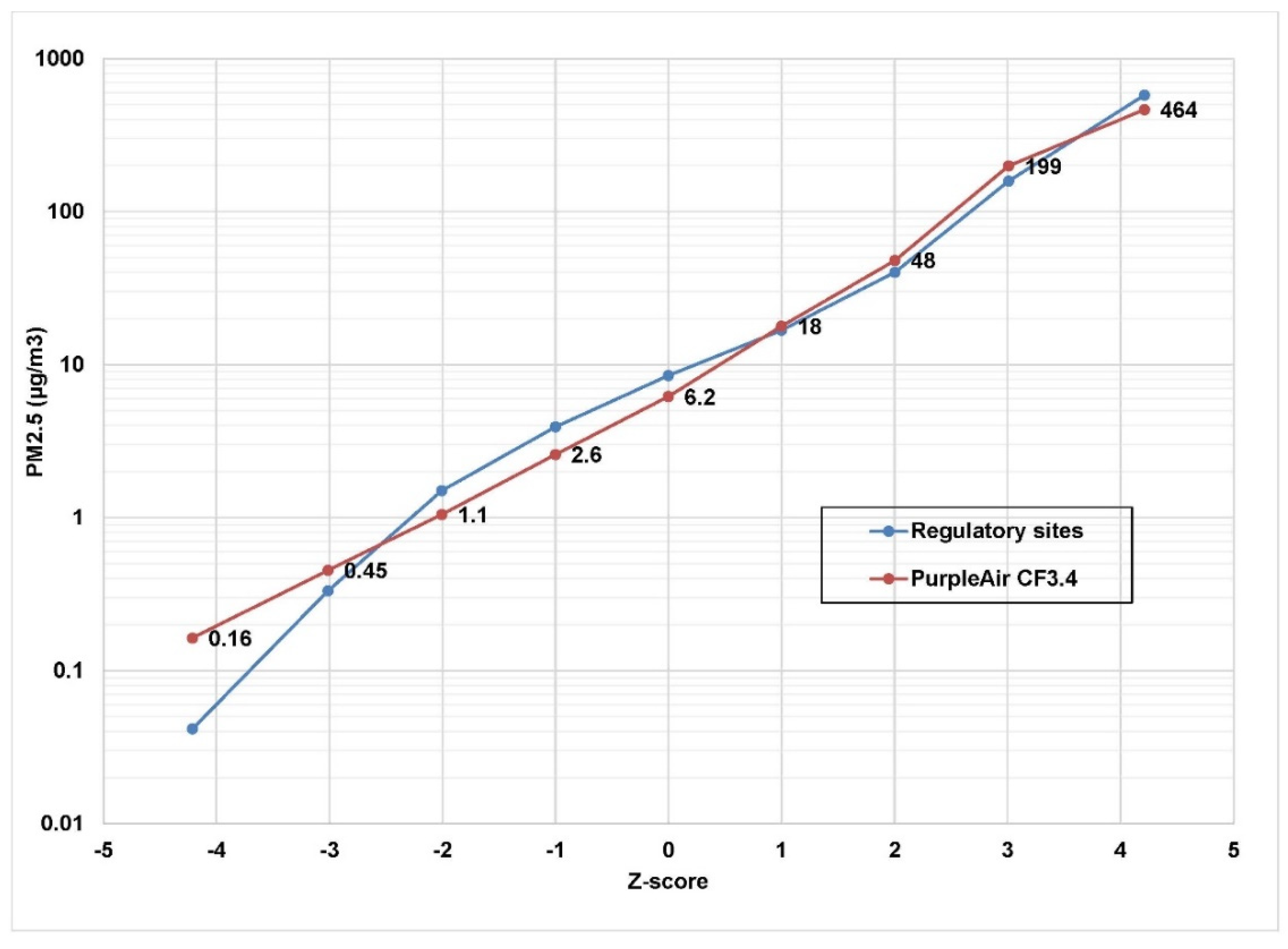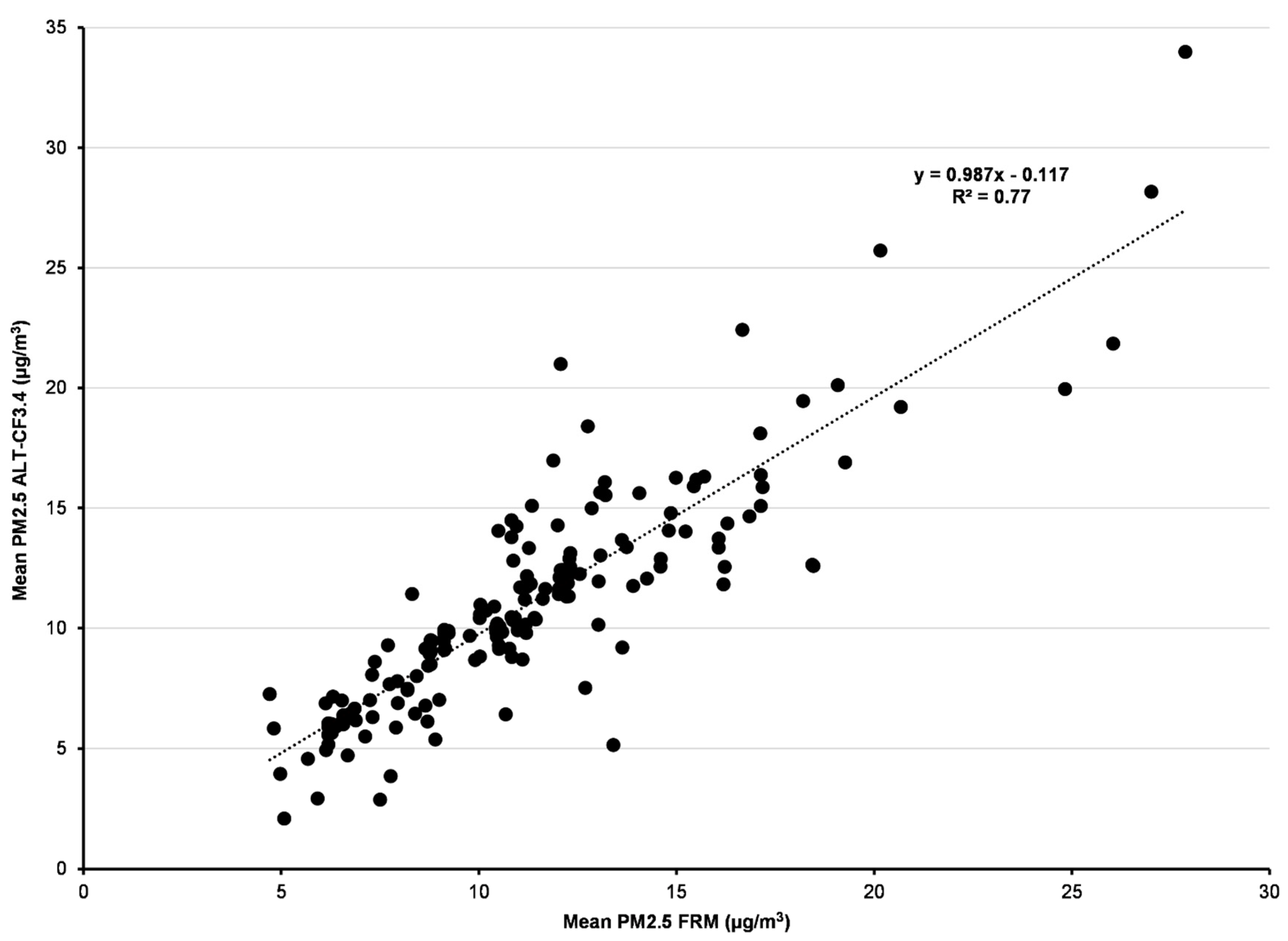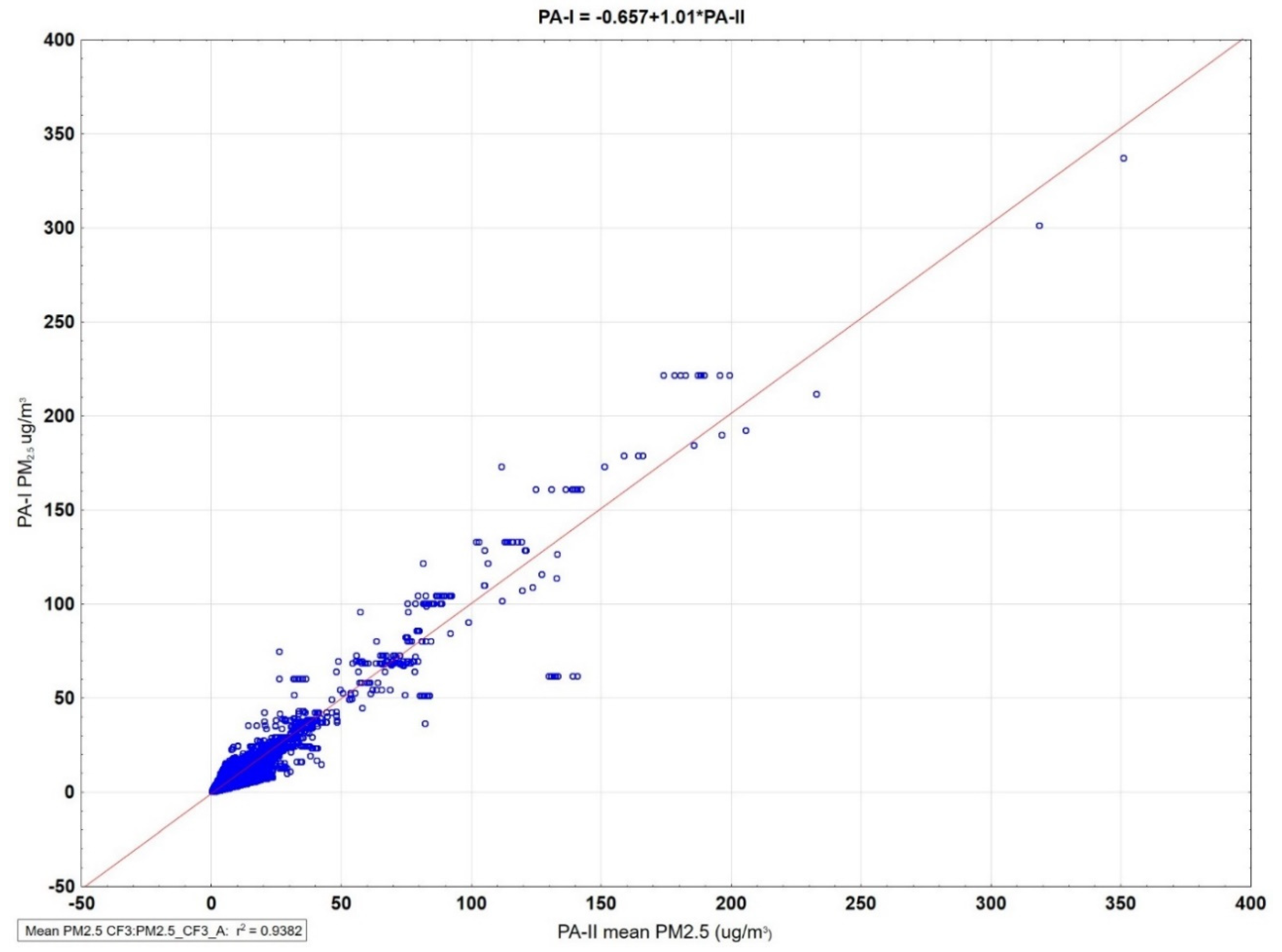Calibration of PurpleAir PA-I and PA-II Monitors Using Daily Mean PM2.5 Concentrations Measured in California, Washington, and Oregon from 2017 to 2021
Abstract
:1. Introduction
2. Materials and Methods
2.1. Obtaining the Data
2.2. Federal and State Agency Data
2.3. Recalibration of PA-II Monitors with PMS-5003 Sensors
- Identify all PurpleAir sites within a specified distance of the target site (e.g., an FRM site). We use several possible distances (0.5, 1, 2, 10 km) to see how distance affects correlations.
- Download the hourly average PM2.5 data calculated using the published calibration factor of 3 in the ALT-CF3 or “PM2.5 alt” algorithms
- Regress the PM2.5 daily measurements at these sites on the target (regulatory) site PM2.5 measurements
- Find the best-fitting (revised) calibration factor by minimizing the mean absolute error (MAE) or the root mean squared error (RMSE) for all pairs of sites. We include both measures to estimate their different effects on the estimated CF.
2.4. New Calibration of PA-I Monitor with PMS-1003 Sensor
3. Results
3.1. Recalibration of PA-II Monitors by Comparison with Regulatory Monitors
3.2. New Calibration of the Outdoor PA-I Monitor with PMS 1003 Sensor vs. Outdoor PA-II Monitors
4. Discussion
4.1. Comparison with Other Algorithms and Effect on the AQI
4.2. Limitations
5. Conclusions
Supplementary Materials
Author Contributions
Funding
Institutional Review Board Statement
Informed Consent Statement
Data Availability Statement
Acknowledgments
Conflicts of Interest
References
- Morawska, L.; Thai, P.K.; Liu, X.; Williams, R. Applications of low-cost sensing technologies for air quality monitoring and exposure assessment: How far have they gone? Environ. Int. 2018, 116, 286–299. [Google Scholar] [CrossRef] [PubMed]
- Levy Zamora, M.; Xiong, F.; Gentner, D.; Kerkez, B.; Kohrman-Glaser, J.; Koehler, K. Field and laboratory evaluations of the low-cost plantower particulate matter sensor. Environ. Sci. Technol. 2018, 53, 838–849. [Google Scholar] [CrossRef] [PubMed]
- Zusman, M.; Schumacher, C.S.; Gassett, A.J.; Spalt, E.W.; Austin, E.; Larson, T.V.; Arvlin, G.C.; Seto, E.; Kaufman, J.D.; Sheppard, L. Calibration of low-cost particulate matter sensors: Model development for a multi-city epidemiological study. Environ. Int. 2020, 134, 105329. [Google Scholar] [CrossRef] [PubMed]
- Kelly, K.E.; Whitaker, J.; Petty, A.; Widmer, C.; Dybwad, A.; Sleeth, D.; Martin, R.; Butterfield, A. Ambient and laboratory evaluation of a low-cost particulate matter sensor. Environ. Pollut. 2017, 221, 491–500. [Google Scholar] [CrossRef] [PubMed]
- Sahimi, T.; Butterfield, A.; Kelly, K.E. Long-term field evaluation of the Plantower PMS low-cost particulate matter sensors. Environ. Pollut. 2019, 245, 932–940. [Google Scholar]
- Gupta, P.; Doraiswamy, P.; Levy, R.; Pikelnaya, O.; Maibach, J.; Feenstra, B.; Polidori, A.; Kiros, F.; Mills, K.C. Impact of California fires on local and regional air quality: The role of a low-cost sensor network and satellite observations. GeoHealth 2018, 2, 172–181. [Google Scholar] [CrossRef] [PubMed]
- He, M.; Kuerbanjiang, N.; Dhaniyala, S. Performance characteristics of the low-cost Plantower PMS optical sensor. Aerosol Sci. Technol. 2020, 54, 232–241. [Google Scholar] [CrossRef]
- Singer, B.C.; Delp, W.W. Response of consumer and research grade indoor air quality monitors to residential sources of fine particles. Indoor Air 2018, 28, 624–639. [Google Scholar] [CrossRef] [PubMed]
- Wang, Z.; Delp, W.W.; Singer, B.C. Performance of Low-Cost Indoor Air Quality Monitors for PM2.5 and PM10 from Residential Sources. Build. Environ. 2020, 171, 106654. [Google Scholar] [CrossRef]
- Bi, J.; Wildani, A.; Chang, H.H.; Liu, Y. Incorporating low-cost sensor measurements into high-resolution PM2.5 modeling at a large spatial scale. Environ. Sci. Technol. 2020, 54, 2152–2162. Available online: https://pubs.acs.org/doi/10.1021/acs.est.9b06046 (accessed on 9 January 2022). [CrossRef] [PubMed]
- Barkjohn, K.; Gantt, B.; Clements, A.L. Development and application of a United States wide correction for PM2.5 data collected with the PurpleAir sensor. Atmos. Meas. Tech. 2020, 4, 10.5194. [Google Scholar] [CrossRef]
- Liang, Y.; Senguta, D.; Campmier, M.J.; Lunderberg, D.M.; Apte, J.S.; Goldstein, A. Wildfire smoke impacts on indoor air quality assessed using crowdsourced data in California. Proc. Natl. Acad. Sci. USA 2021, 118, e2106478118. [Google Scholar] [CrossRef] [PubMed]
- Wallace, L.; Bi, J.; Ott, W.R.; Sarnat, J.A.; Liu, Y. Calibration of low-cost PurpleAir outdoor monitors using an improved method of calculating PM2.5. Atmos. Environ. 2021, 256, 118432. [Google Scholar] [CrossRef]
- Bi, J.; Wallace, L.; Sarnat, J.A.; Liu, Y. Characterizing outdoor infiltration and indoor contribution of PM2.5 with citizen-based low-cost monitoring data. Environ. Pollut. 2021, 276, 116793. [Google Scholar] [CrossRef] [PubMed]
- Plantower. 2016. Available online: https://www.aqmd.gov/docs/default-source/aq-spec/resources-page/plantower-pms5003-manual_v2-3.pdf (accessed on 17 January 2020).
- Ott, W.R. A physical explanation of the lognormality of pollutant concentrations. J. Air Waste Manag. Assoc. 1990, 40, 1378–1383. [Google Scholar] [CrossRef] [PubMed] [Green Version]
- Seinfeld, J.H.; Pandis, S.N. Atmospheric Chemistry and Physics, 3rd ed.; Wiley: New York, NY, USA, 2016. [Google Scholar]
- Hinds, W. Aerosol Technology, 2nd ed.; Wiley: New York, NY, USA, 1999. [Google Scholar]
- Zheng, T.; Bergin, M.H.; Johnson, K.K.; Tripathi, S.N.; Shirodkar, S.; Landis, M.S.; Sutaria, R.; Carlson, D.E. Field evaluation of low-cost particulate matter sensors in high-and low-concentration environments. Atmos. Meas. Tech. 2018, 11, 4823–4846. [Google Scholar] [CrossRef] [Green Version]



| N | Mean | Std. Err. | Min | Z = −1 * | Median | Z = 1 * | Max | |
|---|---|---|---|---|---|---|---|---|
| PM2.5 | 39,474 | 11.5 | 0.076 | 0.042 | 3.9 | 8.5 | 17 | 577 |
| PM2.5 CF3.4 | 39,474 | 11.0 | 0.090 | 0.164 | 2.6 | 6.2 | 18 | 464 |
| PM2.5 CF3 | 39,474 | 9.9 | 0.080 | 0.146 | 2.3 | 5.5 | 16 | 414 |
| Statistic (N = 117 Sites) | Mean | Std. Err. | Lower Quartile | Median | Upper Quartile | 90th Percentile | Max |
|---|---|---|---|---|---|---|---|
| slope (centered) | 0.93 | 0.0094 | 0.90 | 0.98 | 0.99 | 0.99 | 0.999 |
| Adjusted R² | 0.87 | 0.016 | 0.81 | 0.96 | 0.98 | 0.99 | 0.998 |
| Std. Err. of Estimate | 1.7 | 0.10 | 0.81 | 1.5 | 2.3 | 2.8 | 7.4 |
| Number of days | 197 | 10.4 | 92 | 178 | 303 | 344 | 497 |
Publisher’s Note: MDPI stays neutral with regard to jurisdictional claims in published maps and institutional affiliations. |
© 2022 by the authors. Licensee MDPI, Basel, Switzerland. This article is an open access article distributed under the terms and conditions of the Creative Commons Attribution (CC BY) license (https://creativecommons.org/licenses/by/4.0/).
Share and Cite
Wallace, L.; Zhao, T.; Klepeis, N.E. Calibration of PurpleAir PA-I and PA-II Monitors Using Daily Mean PM2.5 Concentrations Measured in California, Washington, and Oregon from 2017 to 2021. Sensors 2022, 22, 4741. https://doi.org/10.3390/s22134741
Wallace L, Zhao T, Klepeis NE. Calibration of PurpleAir PA-I and PA-II Monitors Using Daily Mean PM2.5 Concentrations Measured in California, Washington, and Oregon from 2017 to 2021. Sensors. 2022; 22(13):4741. https://doi.org/10.3390/s22134741
Chicago/Turabian StyleWallace, Lance, Tongke Zhao, and Neil E. Klepeis. 2022. "Calibration of PurpleAir PA-I and PA-II Monitors Using Daily Mean PM2.5 Concentrations Measured in California, Washington, and Oregon from 2017 to 2021" Sensors 22, no. 13: 4741. https://doi.org/10.3390/s22134741
APA StyleWallace, L., Zhao, T., & Klepeis, N. E. (2022). Calibration of PurpleAir PA-I and PA-II Monitors Using Daily Mean PM2.5 Concentrations Measured in California, Washington, and Oregon from 2017 to 2021. Sensors, 22(13), 4741. https://doi.org/10.3390/s22134741





